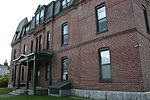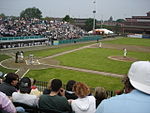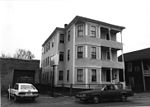Cambridge Street Firehouse
1886 establishments in MassachusettsBuildings and structures in Worcester, MassachusettsFire stations completed in 1886Fire stations on the National Register of Historic Places in MassachusettsGovernment buildings completed in 1886 ... and 3 more
National Register of Historic Places in Worcester, MassachusettsQueen Anne architecture in MassachusettsWorcester, Massachusetts Registered Historic Place stubs

The Cambridge Street Firehouse is a historic fire station at 534 Cambridge Street in Worcester, Massachusetts. The two story brick building was built in 1886 in a Queen Anne style, with some Romanesque details. It is nearly identical to Worcester's Woodland Street Firehouse; both were designed by Fuller & Delano and built the same year.The building was listed on the National Register of Historic Places in 1980, at which time it was still an active firehouse. Engine 14 and Ladder 9 ran out of this station over the years. Engine 14 was eliminated in 1991, Ladder 9 in the 1960s.
Excerpt from the Wikipedia article Cambridge Street Firehouse (License: CC BY-SA 3.0, Authors, Images).Cambridge Street Firehouse
Cambridge Street, Worcester
Geographical coordinates (GPS) Address Nearby Places Show on map
Geographical coordinates (GPS)
| Latitude | Longitude |
|---|---|
| N 42.244111111111 ° | E -71.808944444444 ° |
Address
Cambridge Street 534
01655 Worcester
Massachusetts, United States
Open on Google Maps









